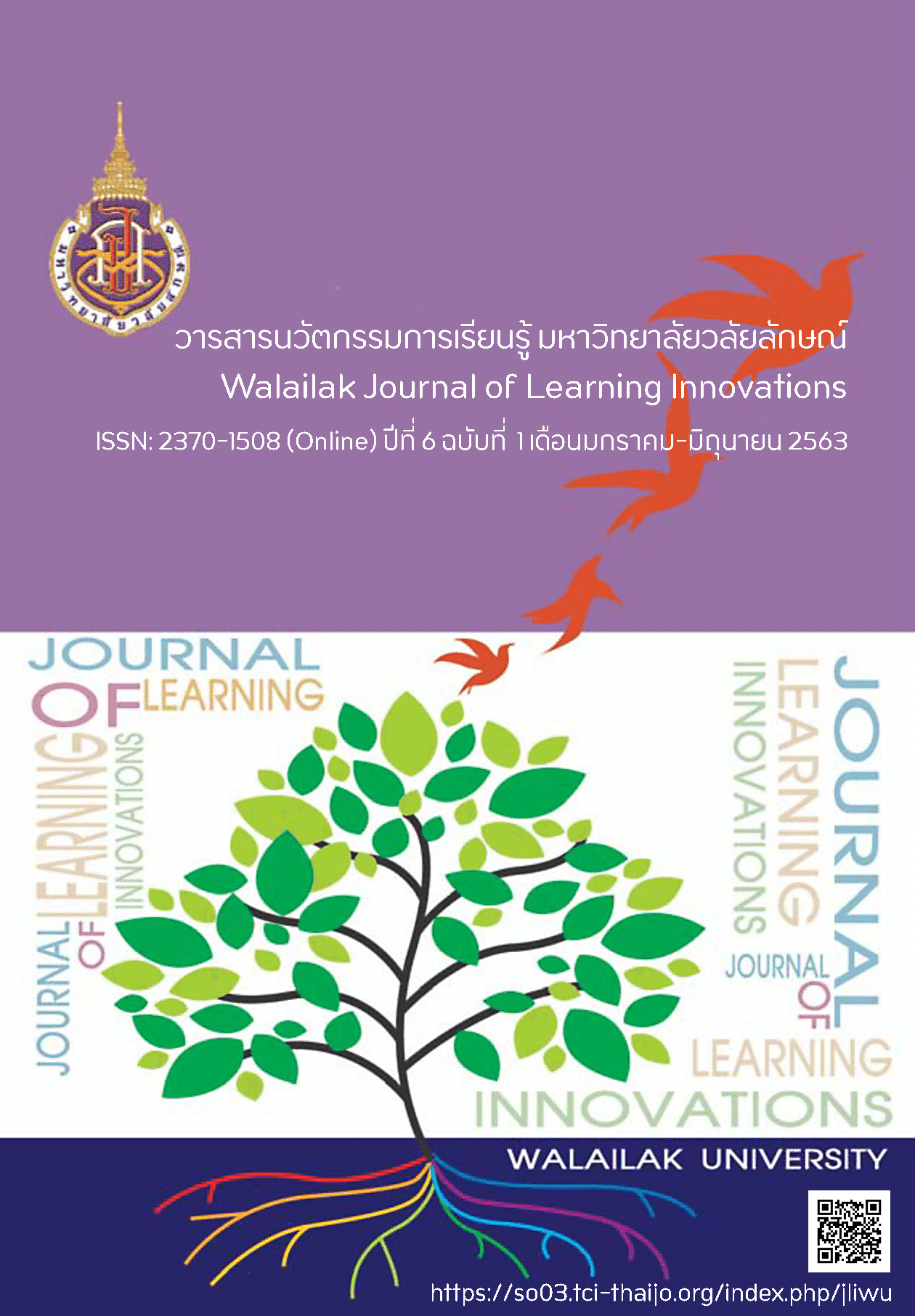Application of Content and Language Integrated Learning (CLIL) Approach for English Learning of Secondary School Bhutanese Students
DOI:
https://doi.org/10.14456/jli.2020.2Keywords:
Content and Language Integrated Learning, English Learning, Secondary school Bhutanese StudentsAbstract
This study aimed to 1) investigate the students language learning achievement in secondary schools with CLIL approach and 2) explore the language learning satisfaction of students with the lessons using CLIL approach in the study. Mixed methods with qualitative and quantitative instruments were employed and Grade 11 Arts Bhutanese students were selected to participate in the study using clustered random sampling method. The researcher collected the quantitative data were collected through the Pre/Post Test and a survey questionnaire, the qualitative data through Classroom Observation (CO).
Findings from the collected data showed significant improvement in the test scores and found students more interested in learning. Students were also found confident relating to the satisfaction learning using CLIL approach. The results showed that the use of CLIL approach was effective in learning English language of the target group.
References
Boonmoh, A. (2018). Teachers' Perceptions towards Promoting Intercultural Communicative Competence in the EFL Classroom. rEFLections , 76-77.
Charalampidi, M., Hammond, M., Hadjipavlou, N., & Lophitis, N. (2017). A Content and Language Integrated Learning (CLIL) Project: Opportunities and Challenges in the Context of Heritage Language Education. European Conference on Language Learning .
Costa, F. (2016). CLIL (Content and Language Integrated Learning) through English in Italian Higher Education . Malino Led: Lingue E Culture Language and Cultures-Langues Et Cultures .
Coyle, D., Hood, P., & Marsh, D. (2010). CLIL Content and Language Integrted Learning . Cambridge : Cambridge University Press.
Creswell, J. W. (2015). A concise Introduction to Mixed Method Research . Los Angeles : SAGE publications. Inc.
Dema, S. (2018). Educating for Gross National Happiness. Victoria: University of Victoria.
Hao , H., Susono , H., & Yamada, M. (2018). EFFECTS OF CONTENT AND LANGUAGE INTEGRATED LEARNING CLASS DESIGN BASED ON THE FIRST PRINCIPLE OF INSTRUCTION THEORY: A CASE STUDY. Tokyo, Japan: Kyushu University.
Hunt, M. (2011). Learners’ perceptions of their experiences of learning subject content through a foreign language. Educational Review , 365-378.
Kampen, E., Admiraal , W., & Berry, A. (2016). Content and language integrated learning in the Netherlands: teachers’ self-reported pedagogical practices. International Journal of Bilingual Education and Bilingualism , Informa UK Limited, trading as Taylor & Francis Group.
Lockley, T. (2015). Promoting international posture through history as content and language integrated learning (CLIL) in the Japanese context. Studies in Second Language Learning and Teaching , 87-108.
Lewandowska-Tomaszczyk, B. (2019). Contacts & Contrasts in Educational Contexts and Translation. Konin, Poland: Springer Nature Switzerland AG.
Lichtman, M. (2013). Qualitative Research in Education A User's Guide . Thousand Oaks, California: SAGE Publications, Inc.
Nitschneider, B. T. (2017). Most Effective Practices for Content and Language Integrated Learning at Hyde Academy, Beijing, China . ProQuest LLC .
Pauly, M. (2017). Content and Language Integrated Learning (CLIL) Through Sign Language (SL). Tokyo, Japan.: Tsukuba University of Technology .
Phuntsho, K. (2013). On the Two Ways of Learning in Bhutan. Journal of Bhutan Studies , 60.
Pennycook, A. (2017). The Cultural Politics of English as an International Language . 2 Park Square, Milton Park, Abingdon, Oxon OX14 4RN: Routledge.
Roy, A. (2013). Retrieved from Essay on Importance of English Language in India: https://www.importantindia.com/2398/essay-on-importance-of-english-language-in-india/
Royal Education Council. (2018). English Curriculum PP-XII. Paro: The School Education and Research Unit:Royal Education Council, Bhutan.
Royal Education Council. Paro: Bhutan. (2016). National School Curriculum Conference 2016; Rethinking Curriculum. Paro: Royal Education Council, Shari, Paro.
Singay. (2018). English Oral Communication Needs of Bhutanese Students: As Perceived by the Teachers and Students . English Language Teaching , 74-81.
Tshewang, U., Morrison, J. G., & Tobias, M. C. (2018). Bionomics in the Dragon Kingdom: Ecology, Economics and Ethics in Bhutan. Thimphu: Fascinating Life Sciences: RGOB, Bhutan.
Downloads
Published
How to Cite
Issue
Section
License
เนื้อหาและข้อมูลในบทความที่ลงตีพิมพ์ในวารสารนวัตกรรมการเรียนรู้ มหาวิทยาลัยวลัยลักษณ์ ถือเป็นข้อคิดเห็นและความรับผิดชอบของผู้เขียนบทความโดยตรง ซึ่งกองบรรณาธิการวารสาร ไม่จำเป็นต้องเห็นด้วย หรือร่วมรับผิดชอบใดๆ
บทความ ข้อมูล เนื้อหา รูปภาพ ฯลฯ ที่ได้รับการตีพิมพ์ในวารสารนวัตกรรมการเรียนรู้ มหาวิทยาลัยวลัยลักษณ์ ถือเป็นลิขสิทธิ์ของวารสารนวัตกรรมการเรียนรุ้ มหาวิทยาลัยวลัยลักษณ์ หากบุคคลหรือหน่วยงานใดต้องการนำทั้งหมดหรือส่วนหนึ่งส่วนใดไปเผยแพร่ต่อเพื่อกระทำการใดๆ จ้อต้องได้รับอนุญาตเป็นลายลักษณ์อักษรจากวารสารนวัตกรรมการเรียนรู้ มหาวิทยาลัยวลัยลักษณ์ก่อนเท่านั้น

